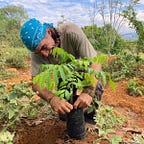Two Things Landscapes Need
I want to begin sharing how we can learn to “activate” the regeneration of entire bioregions…
The work of Bioregional Activators is to create real-world impacts on the ground in different landscapes around the world. This means each landscape needs to learn how to organize itself at the bioregional or territorial scale.
Here in Barichara, we are creating a territorial foundation. It is a specific incarnation of something more general. Not every bioregion needs to create a territorial foundation, but every bioregion DOES need the core capacities enabled by what our territorial foundation is doing.
Also here in Barichara we are creating an ecoversity. This is one way to think about learning ecosystems. All bioregions will need their own ways to organize how territorial-scale learning occurs.
Namely:
- Bioregional Governance :: An institutional framework that is neutral with respect to a diversity of actors in the community and the many themes they care about.
- Learning Ecosystem :: A bioregional learning center that acts as the organization of all regenerative educational activities and the entry point for outsiders to engage in learning exchanges with local projects.
We have been successful at creating some of these capacities in Barichara throughout the last few years. Others are not yet in place and the pain/confusion is palpable. For example, many Earth Regenerators come to Barichara and do not have clear pathways to engage with the local community. How does one arrive and get involved in local projects? And what is needed to create clarity about how to relate to them?
Challenges like these can be addressed by having a clear entry point into the community that holds and facilitates the learning activities for new arrivals. All who attended ReFi Barichara will be aware that a hosted learning space was held throughout the preparation for arrival, during the five days of the event, and is now being sustained afterwards. Any bioregion that wants to receive outsiders will need to create a clear entry point and provide structured activities that enable learning exchanges to occur.
Similarly, the local community will need a way to maintain neutrality with respect to its people and projects. This is the role of the bioregional governance that must be in place. Resources that arrive from outside the territory will come through different levels of engagement. Some arrive directly to the projects themselves in the normal manner. Others will come in the form of community funds or thematic efforts to achieve collective impact.
The institutional framework for bioregional governance will set priorities and establish criteria for the territorial scale. It can convene dialogues and engage in mapping efforts for the bioregion as a whole. And in doing this it becomes a trusted neutral partner between local projects while also enabling the mobilization of value flows across them.
Looking inward, the learning ecosystem coordinates and serves the integration of learning activities throughout the territory. Outwardly it holds coherence with learning and resource exchanges that arrive or depart from the local landscape. These functions are shared with the bioregional governance in the sense that coherence and neutrality are held in service to collective purpose among locals; while also enabling sovereignty to be held as power remains embodied locally when interacting with outside forces.
I wanted to share these insights and design elements with all of you so we can begin imagining how to activate bioregional regeneration efforts in new territories together.
Discussion Questions
Consider the following and share your responses in the comment thread below. Together we will learn how to put these kinds of ideas into practice around the world.
Question #1 :: Is it confusing how bioregional governance relates to the learning ecosystems that are needed?
I am routinely asked what the relationship is between Barichara Ecoversity and the territorial foundation we are creating. This is because they have many blended functions and overlapping of people who are involved. What else makes their relationship confusing? How might we clarify this together with practical experiments?
Question #2 :: What do you see as key elements that will be needed for successful governance and learning processes?
Some elements are named in this brief article. Yet there is much more to elaborate. Can you think of other key elements or design features that will be needed before we can engage new bioregions in a coherent way?
Question #3 :: What can Bioregional Activators offer to new landscapes as we engage them?
When you read this article, my hope is that you will see how learning together will enable us to bring supports to new landscapes. How might we assess the existing capacities of a new landscape in terms of governance and integrative learning? Where might we help if gaps are found? This is an area of open inquiry with many topics to explore.
